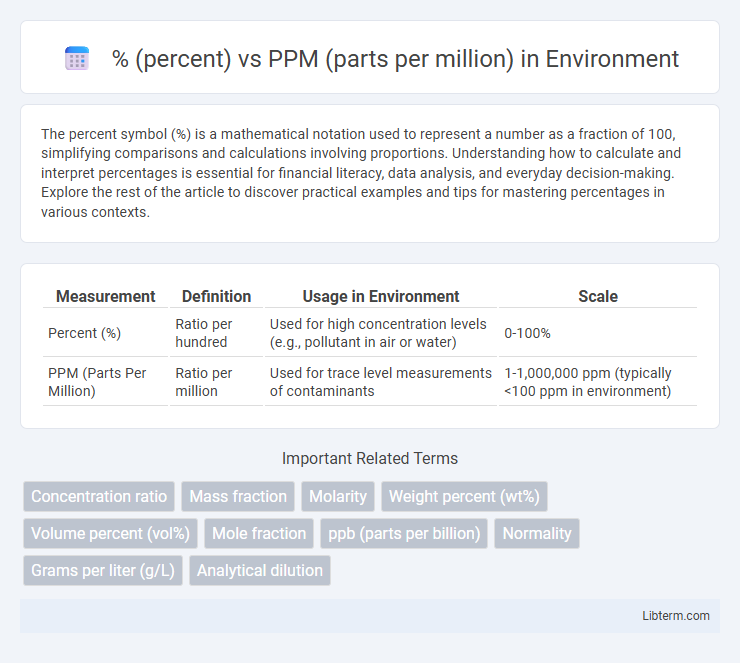The percent symbol (%) is a mathematical notation used to represent a number as a fraction of 100, simplifying comparisons and calculations involving proportions. Understanding how to calculate and interpret percentages is essential for financial literacy, data analysis, and everyday decision-making. Explore the rest of the article to discover practical examples and tips for mastering percentages in various contexts.
Table of Comparison
| Measurement | Definition | Usage in Environment | Scale |
|---|---|---|---|
| Percent (%) | Ratio per hundred | Used for high concentration levels (e.g., pollutant in air or water) | 0-100% |
| PPM (Parts Per Million) | Ratio per million | Used for trace level measurements of contaminants | 1-1,000,000 ppm (typically <100 ppm in environment) |
Understanding Percent (%) and Parts Per Million (PPM)
Percent (%) represents a ratio per hundred, meaning 1% equals one part out of 100 parts, commonly used to express concentrations or proportions in everyday contexts. Parts per million (PPM) measures much smaller quantities, denoting one part out of one million parts, ideal for expressing trace amounts such as pollutant levels in air or contaminants in water. Understanding the relationship between percent and PPM--where 1% equals 10,000 PPM--enables accurate interpretation and conversion in scientific, environmental, and industrial applications.
Defining Percent (%): Meaning and Usage
Percent (%) represents a fraction of 100, commonly used to express proportions, ratios, or concentrations in everyday contexts such as finance, statistics, and chemistry. It quantifies how many parts exist per hundred, facilitating easy comparison and interpretation of data. Unlike parts per million (PPM), which measures much smaller concentrations as the number of parts per one million, percent is ideal for representing larger, more general ratios.
What is PPM (Parts per Million)?
PPM (Parts per Million) is a unit of concentration representing one part of a substance per one million parts of the total mixture, equivalent to 0.0001%. It is commonly used to measure trace amounts of contaminants or pollutants in air, water, and soil for precise environmental monitoring. Unlike percent (%), which denotes parts per hundred, PPM provides a much finer scale essential for detecting low-level concentrations.
Key Differences Between % and PPM
Percent (%) represents a proportion out of 100, making it ideal for describing concentrations or ratios in more substantial quantities, whereas parts per million (PPM) indicates a much smaller ratio, equivalent to one part in one million. Percent values are commonly used in contexts like solution concentrations, interest rates, and statistical data, while PPM is crucial for measuring trace levels of pollutants, contaminants, or elements in air, water, and soil. The key difference lies in their scale and precision: percent offers a broader measurement scale suitable for larger quantities, while PPM provides a finer scale for detecting minute differences.
Conversion: How to Switch Between % and PPM
Converting between percent (%) and parts per million (PPM) involves multiplying or dividing by 10,000, since 1% equals 10,000 PPM. To convert from %, multiply the value by 10,000 to get PPM; to convert from PPM, divide the value by 10,000 to obtain a percentage. Accurate conversion is essential in fields such as chemistry, environmental science, and engineering where precise concentration measurements are critical.
Real-World Applications of Percent and PPM
Percent (%) and parts per million (PPM) are critical measurement units used to quantify concentration levels in various industries. Percent is commonly applied in finance to represent interest rates, in chemistry for solution concentrations, and in statistics to express proportions or probabilities. PPM is essential in environmental science for measuring pollutant levels in air and water, in manufacturing to detect trace contaminants, and in medicine for monitoring very low concentrations of substances in biological samples.
Advantages and Limitations of Using %
Percentage (%) offers a straightforward and intuitive way to express concentration or proportion, making it ideal for general use and easy communication across various fields such as finance, health, and education. However, its limitation lies in lack of precision for extremely low concentrations, where parts per million (PPM) provides a more accurate and sensitive measurement scale, especially relevant in environmental monitoring and chemical analysis. While % simplifies representation, it may obscure trace-level details critical for compliance with strict regulatory standards requiring PPM-level detection.
Advantages and Limitations of Using PPM
Using parts per million (PPM) allows for highly precise measurements of very small concentrations, making it ideal for trace element analysis in environmental monitoring, chemical formulations, and quality control. PPM is advantageous when detecting contaminants or impurities below 0.1% concentration, providing greater resolution compared to percentages (%). However, PPM can be less intuitive for general audiences and may require conversion to percentages for broader comprehension, limiting its usability in non-technical contexts.
Common Mistakes When Using % and PPM
Common mistakes when using % and PPM include confusing their scales, with % representing parts per hundred and PPM representing parts per million, leading to significant errors in measurements. Another frequent error is neglecting to convert between units properly, especially in scientific calculations where precision is critical. Users often overlook the context in which each unit is appropriate, resulting in misinterpretation of concentration levels or contamination limits.
Practical Tips for Accurate Measurement and Reporting
When measuring concentrations, understanding that 1% equals 10,000 ppm is crucial for accurate data conversion and reporting. Use high-precision instruments calibrated specifically for the required scale, whether percentage or ppm, to ensure measurement reliability. Document units clearly in reports to prevent confusion and maintain consistency across scientific and industrial applications.
% (percent) Infographic

 libterm.com
libterm.com